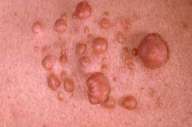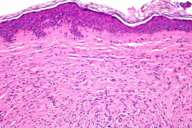Segmental neurofibromatosis
Published Web Location
https://doi.org/10.5070/D394553468Main Content
Segmental neurofibromatosis
Brian Toy MD
Dermatology Online Journal 9(4): 26
From the Ronald O. Perelman Department of Dermatology, New York University
Abstract
Segmental neurofibromatosis is a rare variant of neurofibromatosis in which skin lesions are confined to a circumscribed body segment. A case of a 72-year-old woman with this condition is presented. Clinical features and genetic evidence are reviewed.
Clinical summary
History.—A 72-year-old woman had a 50-year history of lesions on the left upper back. The patient presented to the Charles C. Harris Skin and Cancer Pavilion for a total body skin examination. Multiple papules on the left upper back were asymptomatic and slow-growing.
Past medical history includes inverse psoriasis, diabetes mellitus, hypertension, hypothyroidism, and endometriosis. Medications include gemfibrozil, captopril, amlodipine, and thyroxine. There is no family history of neurofibromatosis.
Physical examination.—Multiple, soft, dome-shaped, flesh-colored papules were located over a circumscribed area on the left upper back. Café-au-lait macules and axillary freckling were absent.

|

|
| Figure 1 | Figure 2 |
|---|
Laboratory data.—None.
Histopathology.—Hematoxylin-and-eosin stained sections show a dermal proliferation of spindle cells with wavy nuclei and inconspicuous nucleoli. The interspersed stroma is composed of fibrillary collagen. The overlying epidermis shows no significant changes.
Diagnosis.—Segmental neurofibromatosis.
Comment
Segmental neurofibromatosis (neurofibromatosis type V) is a rare disorder characterized by cutaneous neurofibromas, with or without café-au-lait macules, that are limited to a circumscribed body segment [1, 2, 3]. The affected area can vary in size from a narrow strip to an area encompassing half of the body. Distribution may be unilateral or bilateral and symmetric or asymmetric [4].
Segmental neurofibromatosis has been described in 82 patients worldwide, with a median age of onset of 28 years [1]. Skin lesions are most commonly found in a unilateral distribution over a cervical or thoracic dermatome. Café-au-lait macules have been reported to occur in 26 percent, although axillary freckling has been described in only nine patients [1]. Systemic disease is uncommon, and most patients have no family history of neurofibromatosis.
Segmental neurofibromatosis is thought to arise from a postzygotic neurofibromatosis type 1 (NF1) gene mutation. An NF1 microdeletion was identified in a patient with segmental neurofibromatosis using fluorescent in situ hybridization [5]. The mutant allele was present in a mosaic pattern in cultured fibroblasts but was absent from fibroblasts obtained from the patient's normal skin.
Individuals with segmental neurofibromatosis have a low risk of passing this disease to offspring. Two instances have been reported in which a parent with segmental neurofibromatosis had an offspring with neurofibromatosis of the generalized type. It is thought that, if a somatic mutation occurs early enough, it will result in generalized disease, which is clinically indistinguishable from the nonmosaic form of the disease [4].
References
1. Hager C, et al. Segmental neurofibromatosis: case reports and review. J Am Acad Dermatol 1997;37:864.2. Trattner A, et al. Segmental neurofibromatosis. J Am Acad Dermatol 1990;23:866.
3. Moss C, Green S. What is segmental neurofibromatosis? Br J Dermatol 1994;130:106.
4. Ruggieri M. The clinical and diagnostic implications of mosaicism in the neurofibromatoses. Neurology 2001;56:1433.
5. Tinschert s, et al. Segmental neurofibromatosis is caused by somatic mutation of the neurofibromatosis type 1 (NF1) gene. Eur J Hum Genet 2000;8:455.
© 2003 Dermatology Online Journal

